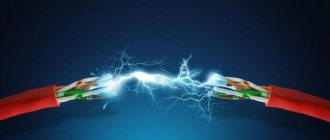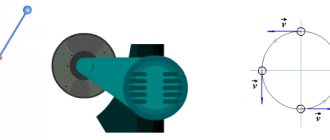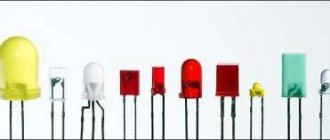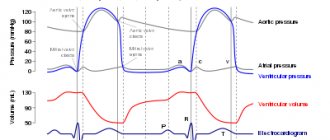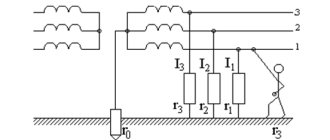In order to understand how high-quality voltage is supplied to our outlet, two things are needed - to know the quality standards and to know how to measure these standards. In this article I will tell you in detail what voltage quality is and how to measure its characteristics. This will not be a theoretical Wikipedia article, but material as close as possible to real life.
Let's see what we can measure and see in reality in the power supply network. I will provide official quality standards and show what can actually happen on the network.
How and why to evaluate the quality of voltage in the network?
Really, why? After all, all you have to do is press a button on the TV remote control or plug your iPhone charger into a power outlet and enjoy the benefits of electrification throughout the country!
But there are times when something goes wrong: the crocodile is not caught, the iPhone does not charge, the air conditioner produces a strained hum instead of coolness, and the TV shows no signs of life after a click.
Knowledgeable people have gathered here who understand that the values of the main parameters of the electrical network - voltage and frequency - can be found out primarily using a multimeter. But what to do if you need to see what is happening in the outlet during the day? But what if you need to track a voltage surge that is much shorter in time than the multimeter measurement interval? Moreover, it may be that the time of appearance of this artifact is unknown.
Usually, for any voltage problems, stabilizers are installed, but they do not always help. After all, the stabilizer eliminates the effect, but not the cause of the problem. And if there is an abrupt short-term change in voltage, then the stabilizer will not only not help, but will also worsen the situation.
And in order to understand what to do in this or that case - check the quality of the contacts at the input or install a stabilizer - you need a Power Quality Analyzer.
A power quality analyzer provides a complete picture of what is happening at the outlet.
In my work I use the HIOKI 3197 electrical energy quality analyzer, photos of which will be given in the article.
Without a quality analyzer, it is often completely unclear what is happening in the network: what kind of interference, surge voltages and dips, power factor cos, and so on. You have to act at random, using your experience and experiments. And with the Japanese HIOKI from Nagano everything is clear. In order to get a complete picture of what is happening in the network, the device has clamps for measuring current and clamps for measuring voltage, as well as a clamp for connecting to the neutral. Total - 7 connection points.
Power Quality Analyzer
A real case when you can’t do without a quality analyzer. The controller in the production line periodically froze and generated errors. When everything was shoveled, but the cause was not found, a power quality analyzer came to the rescue. After a short observation of the 220 V voltage supplied to the controller, it turned out that the reason was poor contact inside the surge protector.
How many hertz does a good TV have?
This indicator should not be confused with the filming rate, which is 24 frames per second, or the television content rate, which is 50 frames. The refresh rate of a TV screen—or scan rate—is measured in Hz (hertz). The Hz indicator indicates how many frames per second the panel is capable of displaying.
The higher this characteristic, the clearer the picture will be, without “blurred” movements and flickering.
If we delve a little deeper into history, then obsolete monitors and televisions had a modest frequency of 50 Hz, not hiding “blurred” scenes when the object moved quickly. Later they were replaced by more technologically advanced devices with 100Hz scanning. The new products have completely eliminated the unpleasant flicker, but there is still no talk of quality. As stated above, TV content produces 50 frames per second (which is equal to 50Hz), the updated models “completed” intermediate frames, thereby slightly increasing image clarity to a satisfactory level. But compared to their predecessors, TVs were considered excellent, and there was no better alternative.
High image quality will be ensured by at least 200Hz, when digital video processing projects three additional intermediate frames . Although the manufacturer promises that 100Hz is enough for modern technology, this is not entirely true. It is enough to turn on two TVs with different frequencies: in comparison, the difference in quality when scanning at 100 and 200 Hz will be noticeable. But screen resolution should also be taken into account. For modern types of TVs, 4K 120 Hz is quite enough.
Mains voltage
This is the most important parameter that mainly determines the quality and characteristics of the entire power system.
The old GOST 13109-97 “Standards for the quality of electrical energy in general-purpose power supply systems” states that the effective (or root mean square, which is the same for sine wave) phase voltage in the supply network should be 220±10%=198...242 V.
However, the new GOST 29322-2014 “Standard Voltages” “increased” the voltage to 230 V±10% =207...253 V. In this case, a voltage of 220 V is allowed. Linear voltages (between phases) will be 380 and 400 V,
It turns out that if the voltage in the outlet “floats” from 198 to 253 V, then this is within the norm.
Consider a three-phase power system. An example of what can happen at the input to the control cabinet is visible on the screen of the HIOKI 3197 power quality analyzer.
Phase voltages in a three-phase network
The graphs show that the phase voltage level fluctuates around an average level of 238–240 V during a measurement time of 2 minutes. Judging by the identical dips in all phases, during this time a relatively powerful three-phase load was switched on several times.
The voltage graph shown above can be recorded in the device’s memory for several days. Thus, you can analyze how the voltage changes during the day and select a stabilizer. Or don’t install it at all, but repair the electrical wiring or file a claim with the energy supply organization.
In addition (which is very important!), you can record and view all voltage artifacts. For example, voltage surges and dips (consequences of poor contacts or interference), starting moments of powerful drives, etc. Event thresholds are set in the settings. Example of a screen showing events:
Events and details on the power quality analyzer screen
Electrical current
Once upon a time as a child, my father bought me my first tester TL-4M. I measured everything until a “brilliant” idea came to my head - to measure the current in the socket. As a result, the plugs were knocked out, the shunt burned out in the tester, and I realized that the current is always measured only through the load. Since then, the means of measuring current have made great strides forward, and for this purpose only current clamps are used (transformer method), shunts are practically not used.
The current, more precisely, its value, shape and components, depends significantly on the load. For example, here is what the voltage and current waveform looks like when the dimmer is operating:
Mains voltage and current THROUGH the dimmer
Naturally, current and voltage harmonics are present. Harmonics talk about how voltage and current waveforms differ from sinusoidal ones.
Voltage and current harmonics
Voltage and current harmonics can be seen in graphical form, both in the screenshot above and in table form - from the 1st to the 50th harmonics. For both single-phase and three-phase networks.
What does resolution affect?
When talking about the scanning frequency of a TV, one cannot fail to mention other important parameters. In addition to the above indicator, it is worth paying attention to the screen resolution, which also affects the image quality. The indicator is measured in pixels (p).
It is worth noting that the continuous development of technology and its improvement leads to the fact that each new model is significantly better than the previous one. About five years ago, 720p devices were at the peak of popularity, and Full HD 1080p models had just appeared and cost twice as much, but today their cost is almost equal. The modern market has been updated with a new HDTV resolution - 4K Ultra HD, capable of displaying four times more pixels than Full HD.
The new UHDTV or 4K has greater color reproduction, the scanning frequency of 120Hz provides clean, clear and realistic images. It is difficult to assess what is better: complete immersion in 3D or ultra-realistic pictures of a new resolution format. But don’t write off Full HD at 1080p. Although the permit is fading into the background, it will be actively used for a long time. Most content is “tailored” for this resolution, unlike the new UHDTV, for which almost no films have yet been released, and the existing ones are not cheap. Therefore, you can only choose which TV resolution is better based on the quality of the incoming signal.
Moreover, the weight of such a file is much greater; the current cables, Internet speed and Wi-Fi router will also have to be replaced with faster and more powerful ones, capable of playing and displaying video in an ultra-precise format.
Frequency
Everyone knows that the frequency of the supply voltage in our outlet is 50 Hz. This means that everything is repeated 50 times per second. In other words, the duration of the voltage period is 20 ms. More precisely, according to GOST 29322-2014, the voltage frequency should be 50±0.2 Hz. That is, from 49.8 to 50.2 Hz.
Perhaps frequency is the only parameter that is not affected by anything. And its stability depends only on the operation of the power plant. This is what the frequency graph looks like on the screen of a power quality analyzer:
Mains frequency
The graph shows that the frequency deviates by no more than 0.03 Hz from the nominal value, which is within GOST standards by a large margin.
Where did they even come from?
The world began to electrify at the end of the 19th – beginning of the 20th centuries. In America, Edison and Westinghouse were at its origins; Europe was “accustomed” to the electric power industry mainly by German engineers. The standard frequencies 50 and 60 Hz were chosen, in general, relatively randomly from the range 40...60 Hz. The range limits were not chosen by chance: at a frequency below 40 Hertz, arc lamps, which were the main electric source of artificial lighting at that time, could not work, and at a frequency above 60 Hz, asynchronous electric motors designed by Nikola Tesla, the most common at that time, did not work...
In Europe, the 50 Hz standard was chosen (the “golden mean”!), while the Americans adopted the 60 Hz standard - arc lamps worked more stably at this frequency. More than a century has passed, arc lamps have become a rarity, but the standards remain - and this difference of 10 Hz practically does not affect the performance of electrical equipment. The voltage in the electrical network is much more important - in many countries it is approximately half as low as in Russia! And the frequency... in Japan, for example, in a third of prefectures the standard is 60Hz, in the remaining two-thirds the standard is 50Hz.




